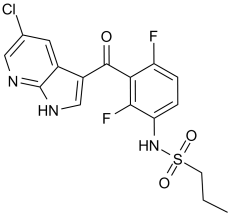This product is for research use only, not for human use. We do not sell to patients.

| Size | Price | Stock |
|---|---|---|
| 500mg | $430 | Check With Us |
| 1g | $645 | Check With Us |
| 5g | $1630 | Check With Us |
Cat #: V1002 CAS #: 918505-84-7 Purity ≥ 98%
Description: PLX4720 (PLX-4720; PLX 4720), a 7-azaindole/pyrrolopyridine-based vemurafenib derivative discovered by a structure-guided discovery approach, is a novel, potent and selective inhibitor of B-RafV600E mutant with potential antitumor activity.
Publications Citing InvivoChem Products
Product Promise

- Physicochemical and Storage Information
- Protocol
- Related Biological Data
- Stock Solution Preparation
- Quality Control Documentation
| Molecular Weight (MW) | 413.83 |
|---|---|
| Molecular Formula | C17H14ClF2N3O3S |
| CAS No. | 918505-84-7 |
| Storage | -20℃ for 3 years in powder formr |
| -80℃ for 2 years in solvent | |
| Solubility In Vitro | DMSO: 83 mg/mL (200.6 mM)r |
| Water: <1 mg/mL (slightly soluble or insoluble)r | |
| Ethanol: <1 mg/mL | |
| Solubility In Vivo | 2% DMSO+50% PEG 300+5% Tween 80+ddH2O: 5 mg/mL |
| SMILES Code | CCCS(=O)(NC1=CC=C(F)C(C(C2=CNC3=NC=C(Cl)C=C32)=O)=C1F)=O |
| Synonyms | PLX 4720; PLX4720; PLX-4720 |
| Protocol | In Vitro | PLX-4720 displays >10 times selectivity against wild type B-Raf, and >100 times selectivity over other kinases such as Frk, Src, Fak, FGFR, and Aurora A with IC50 of 1.3-3.4 μM. PLX-4720 significantly inhibits the ERK phosphorylation in cell lines bearing B-RafV600E with IC50 of 14-46 nM, but not the cells with wild-type B-Raf. PLX-4720 significantly inhibits the growth of tumor cell lines bearing the B-RafV600E oncogene, such as COLO205, A375, WM2664, and COLO829 with GI50 of 0.31 μM, 0.50 μM, 1.5 μM, and 1.7 μM, respectively. In addition, PLX-4720 treatment at 1 μM induces cell cycle arrest and apoptosis exclusively in the B-RafV600E-positive 1205Lu cells, but not in the B-Raf wild-type C8161 cells. |
|---|---|---|
| In Vivo | Oral administration of PLX-4720 at 20 mg/kg/day induces significant tumor growth delays and regressions in B-RafV600E-dependent COLO205 tumor xenografts, without obvious adverse effects in mice even at dose of 1 g/kg. PLX-4720 at 100 mg/kg twice daily almost completely eliminates the 1205Lu xenografts bearing B-RafV600E, while has no activity against C8161 xenografts bearing wild-type B-Raf. The anti-tumor effects of PLX-4720 correlate with the blockade of MAPK pathway in those cells harboring the V600E mutation. |
| Solvent volume to be added | Mass (the weight of a compound) | |||
|---|---|---|---|---|
| Mother liquor concentration | 1mg | 5mg | 10mg | 20mg |
| 1mM | 2.4165 mL | 12.0823 mL | 24.1645 mL | 48.3290 mL |
| 5mM | 0.4833 mL | 2.4165 mL | 4.8329 mL | 9.6658 mL |
| 10mM | 0.2416 mL | 1.2082 mL | 2.4165 mL | 4.8329 mL |
| 20mM | 0.1208 mL | 0.6041 mL | 1.2082 mL | 2.4165 mL |
This equation is commonly abbreviated as: C1 V1 = C2 V2
- (1) Please be sure that the solution is clear before the addition of next solvent. Dissolution methods like vortex, ultrasound or warming and heat may be used to aid dissolving.
- (2) Be sure to add the solvent(s) in order.




































